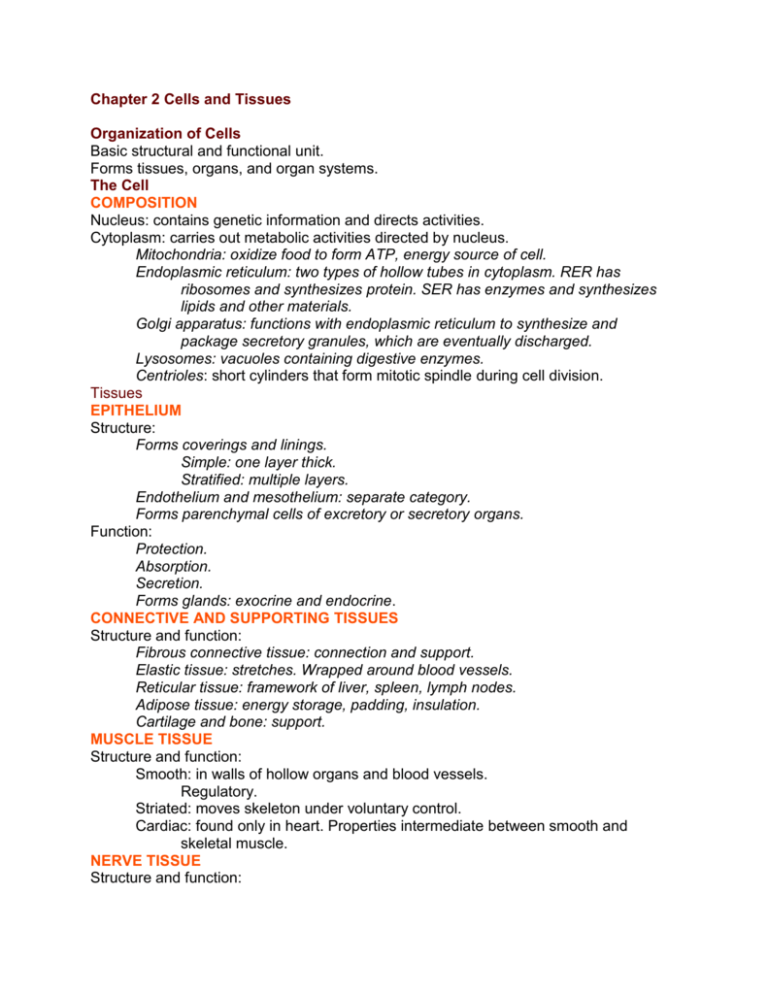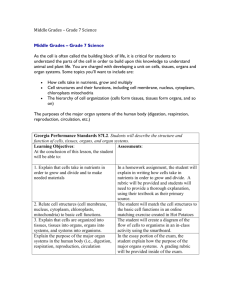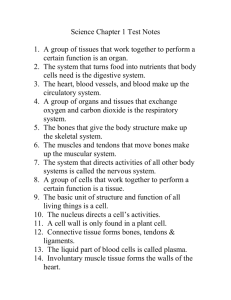Chapter 2 Cells and Tissues
advertisement

Chapter 2 Cells and Tissues Organization of Cells Basic structural and functional unit. Forms tissues, organs, and organ systems. The Cell COMPOSITION Nucleus: contains genetic information and directs activities. Cytoplasm: carries out metabolic activities directed by nucleus. Mitochondria: oxidize food to form ATP, energy source of cell. Endoplasmic reticulum: two types of hollow tubes in cytoplasm. RER has ribosomes and synthesizes protein. SER has enzymes and synthesizes lipids and other materials. Golgi apparatus: functions with endoplasmic reticulum to synthesize and package secretory granules, which are eventually discharged. Lysosomes: vacuoles containing digestive enzymes. Centrioles: short cylinders that form mitotic spindle during cell division. Tissues EPITHELIUM Structure: Forms coverings and linings. Simple: one layer thick. Stratified: multiple layers. Endothelium and mesothelium: separate category. Forms parenchymal cells of excretory or secretory organs. Function: Protection. Absorption. Secretion. Forms glands: exocrine and endocrine. CONNECTIVE AND SUPPORTING TISSUES Structure and function: Fibrous connective tissue: connection and support. Elastic tissue: stretches. Wrapped around blood vessels. Reticular tissue: framework of liver, spleen, lymph nodes. Adipose tissue: energy storage, padding, insulation. Cartilage and bone: support. MUSCLE TISSUE Structure and function: Smooth: in walls of hollow organs and blood vessels. Regulatory. Striated: moves skeleton under voluntary control. Cardiac: found only in heart. Properties intermediate between smooth and skeletal muscle. NERVE TISSUE Structure and function: Impulse transmission. Composed of nerve cells and supporting cells: neuroglia. Organs and Organ Systems ORGANS A group of different tissues integrated to perform a specific function. Composed of parenchymal (functional) cells and stromal (supporting) cells. ORGAN SYSTEMS A group of organs that perform related functions: for example, reproductive system. The Germ Layers and Their Derivatives FUNCTION Embryonic cell layers that give rise to specific tissues and organs. Ectoderm: external coverings, nervous system, eyes, ears. Entoderm: lining of body and associated organs. Mesoderm: supporting tissue, muscle, circulatory system, urogenital system. Cell Function and the Genetic Code FUNCTION DNA composed of chains of nucleotides containing genetic information. In cell division, original chain serves as model for building new chain. GENETIC CODE Nucleus directs activities of cytoplasm by means of mRNA, which attaches to ribosomes and directs protein synthesis. Transfer RNA brings amino acids to ribosomes for assembly as specified by nucleotides in mRNA. Movement of Materials Into and Out of Cells DIFFUSION AND OSMOSIS: PASSIVE PROCESSES Diffusion: movement of solute from concentrated to dilute solution. Osmosis: movement of water from dilute to more concentrated solution. Osmotic pressure: a measure of concentration. Depends on number of dissolved particles. Tonicity often used interchangeably with osmolarity. ACTIVE TRANSPORT: EXPENDS ENERGY Transfer of materials against a concentration gradient. Necessary to maintain proper concentration of intracellular and extracellular ions. PHAGOCYTOSIS AND PINOCYTOSIS: INGESTION BY CELL Phagocytosis: ingestion of particulate material. Pinocytosis: ingestion of water. Adaptations of Cells to Changing Conditions NATURE OF ADAPTATIONS Atrophy: reduction in size in response to unfavorable conditions. Hypertrophy: increase in cell size for more efficient function. Hyperplasia: increase in number of cells to increase functional capabilities. Metaplasia: change from one type of cell to a more resistant type. Dysplasia: disturbed development. May proceed to neoplasia. Increased enzyme synthesis: adaptation in order to inactivate or detoxify materials more efficiently. Cell Injury, Cell Death, and Cell Necrosis CELL INJURY Cell swelling: mechanism for transporting sodium out of cell begins to fail when cell is injured. Sodium diffuses into cell along with water, causing cell to swell. Fatty change: fat metabolism impaired; fat accumulates in cell. CELL DEATH AND NECROSIS Cell death follows irreparable injury. Structural changes that follow called cell necrosis. PROGRAMMED CELL DEATH: APOPTOSIS Cells have predetermined life span and are genetically programmed to die eventually. If regulatory mechanisms fail, cells continue to proliferate. Accumulation of excessive numbers of cells disrupts organ functions. Some tumors result from failure of regulatory mechanisms controlling cell longevity. Aging and the Cell BASIC CONCEPTS Cells and organisms have predetermined life span. Harmful environmental factors damage DNA, RNA, and organelles. This shortens life span. Cells are capable of repairing damage. The more efficient the repair process, the greater the likelihood of cell survival.








